A few days ago, I went to see The Enchanted Interior at the Guildhall Art Gallery, curated and developed by the Laing Art Gallery and Madeleine Kennedy, and adapted by the Guildford Art Gallery. It examined the fascination Oriental art and life in the Middle East held for Mid-Victorian to early 20th century British artists. What appears to have attracted them most was the allure of beautiful women hidden away in harems, living in a ‘gilded cage’. The exhibition is full of pictures of exotic Oriental interiors – usually in Constantinople (Istanbul) or Cairo, or somewhere similar. There are elaborately ornamental wooden grilles to keep the women safe from prying eyes; exotic, colourful Oriental carpets; maids bringing in food and drink; and – probably most the important – the women lounging on the carpets or ottomans all seem perfectly contented.

John Frederick, Life in the Harem, Cairo. 1858. The lady lounges on an ottoman, she has flowers in her lap. A female servant enters with refreshments. A eunuch follows her.
There are several interesting points the exhibition wants to make; one is about Imperialism as experienced by the rise of the British Empire which reached its height in the second half of the 19th century. This was an era when goods from various countries under Imperial British control poured into British ports: cotton, tea, spices, luxury goods, indigo, diamonds, and so on. Almost overnight, it seemed, Britain became hugely wealthy and wielded immense power over ‘an Empire on which the sun never sets’, as maps of the world with British possessions coloured red, proudly pointed out.
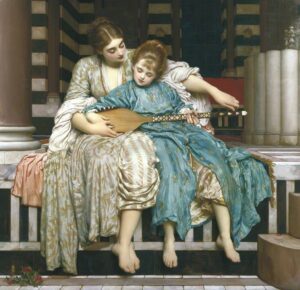
A young woman teaches a young girl to play a stringed instrument – they are at ease with each other and absorbed in what they are doing – they remind me of the scene in Mamma Mia where Donna and Sophie snuggle up together! I like the touch of salmon pink which brings the painting to life.
The exhibition examines one of the concomitants of sudden wealth; who pays the emotional price? The Enchanted Interior specifically looks at the effect on how women – or, more accurately, ladies, were viewed.
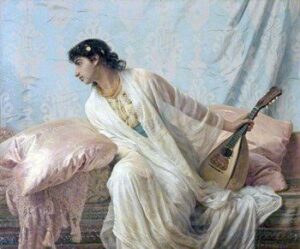
Edwin Long: ‘Then to her listening ear chords came familiar, sweet and low.’ 1881. The girl with the mandolin looks out of the window. In 1874, Long visited both Egypt and Syria. Interestingly, the girl here is one of the few models in the exhibition who looks as though she might actually come from one of those countries – which makes a pleasant change from the mostly white models in pretend Oriental dress.
However, if we look at what was going on back in Britain, we find that things are far from rosy. The government might like to think Britain had ‘dominion over palm and pine’, but this was by no means the case in reality. India had already made her opposition to British rule clear in what the British significantly chose to call the Indian Mutiny in 1854-6; and, at home, Chartists were fighting for the Rights of Man, specifically Manhood Suffrage. The women’s activist, Barbara Bodichon (1827-1891), and others fought tirelessly for married women to be granted legal recognition; for women’s right to work, to vote, and to have equal access to education. The Married Women’s Property Act of 1882, gave women legal recognition which allowed them to keep their own earnings, but Bodichon died before women were given the vote or were granted an Oxford or Cambridge University degree. Change came at a snail’s pace – a lot of vested interests were involved.
.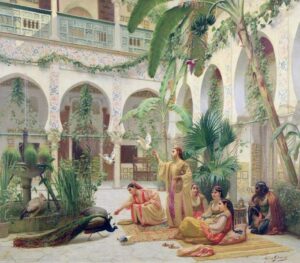
Moorish Courtyard by Paul-Albert Girard. Towneley Hall Art Gallery and Museum, Burnley
However, if we turn back to male fascination with the enclosed world of the Oriental harem, we can see that there, the view was that women’s natural place was in the home, as the above picture shows. As John Ruskin put it in his essay, ‘Of Queen’s Gardens’: ‘by her office and place (as a woman at home) she is protected from all danger and temptation. The man, in his rough work in open world, must encounter all peril and trial … but he guards the woman from all this, within his house, as ruled by her she must be enduringly, incorruptibly good, instinctively, infallibly wise – wise not for self-development, but for self-renunciation…’
What is interesting is that most of the models who sat for the artist’s harem ladies were, plainly, white. The only women of colour in the picture is squatting on the extreme right, and she is cast in the role of a servant. Perhaps the artists wanted to enhance the appeal of cloistered white women to other women back in Britain who might otherwise be getting above themselves and start agitating for unnecessary things, like the vote. Look, they are saying, these women are living happily in a harem; surely you can see that it’s the best place for women to be?
Nowadays, of course, it might look more like permanent lockdown.

J. F Lewis ‘Hhareem Life, Constantinople’ 1857 Laing Art Gallery, Newcastle. Interestingly, the model for the lounging lady is Lewis’s wife.
Plainly, however, a luxurious enclosed life did not refer to working-class women toiling away for a pittance in a noisy and unhealthy cotton mill, breathing in harmful cotton dust which could kill her; nor for a skivvy slaving away eleven hours a day in a house which lacks all modern conveniences: no electricity, no gas, possibly no running water, with heavy coal scuttles to carry, and slops to empty.
The women in the pictures shown in the exhibition are not actually doing anything – and, this is the important thing, they are perfectly happy with that. Ruskin would have approved.
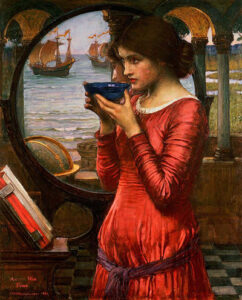
‘Destiny’ by John William Waterhouse R.A. 1906 Towneley Hall Art Gallery and Museum, Burnle;y
The lady in red above is holding up a blue glass bowl to drink a farewell toast to the success of the departing heroes in the two ships we can see in the mirror behind her. Confusingly, the mirror reflects the view through the window on the other side of the building she is in. There is an open book on the table in front of her and a globe on the window sill. The painting’s title is Destiny, but will it be good or bad?
Personally, I’d like her to check that the heroes really have gone, before skipping off to a meeting with Barbara Bodichon and her friends at Langham Place to plan the next campaign for women’s rights!
Above all, as you walk round, you realize that the pictures say a lot more about male fantasies than the reality of life in a harem. None of the male painters had ever actually been inside a harem, and seen it for themselves, though a number of them had lived for a while in Egypt and Constantinople.
On the wall in the exhibition, there is a telling comment written by the Ottoman Princess Senila Sultan from her letter to a friend, which says: The things they make up about us are unimaginable. So be it. They believe that we are slaves, that we are shut up in chambers and left to die. We live in our cages, dressed in costumes of pink and light green satin and dance and sing songs, partaking in poetic fashion of rose confitures, narghiles (hookahs) and even pipes of opium.
You, however, know very well what we are in fact: we are – God be Praised – not unlike other women.
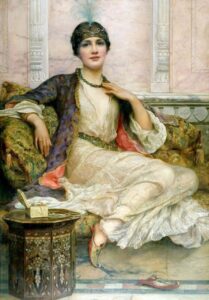
Jade Necklace for an Eastern Princess by William Charles Wontner, 1908. Towneley Hall Art Gallery and Museum, Burnley
I’m ending with the painting above which shows how long the taste lasted for ladies dressed in vaguely Oriental apparel and lounging in comfort in a supposedly Oriental room (furniture probably courtesy of Liberty’s). The model wears Oriental mules with the toes curling up to a point. A close-fitting embroidered skull cap with a turquoise feather sticking up from the centre sits on her head. Her hair, however, is very 1908, and cut short. She fingers the jade necklace of the title.
It was interesting to see just how many of the paintings in the exhibition were borrowed from the art collections of towns and cities which had risen with the Industrial Revolution. New-made men spent their money on modern paintings they liked – and, plainly, a touch of Orientalism with pretty but passive ladies ticked all the right boxes for suitable paintings to sit on the walls of boardrooms and offices. Several paintings came from the Towneley Hall Art Collection in Burnley – which was a major cotton town; others from the Laing Art Gallery in Newcastle, (which co-curated the exhibition) for example, as well as those paintings belonging to the City of London Corporation in the Guildhall Art Gallery.
I’ve very much enjoyed writing this blog – Oh the relief to get out and actually see an exhibition for myself!
Elizabeth Hawksley
Elizabeth’s e-book ‘Highland Summer’ is now out
Please share this page...
An interesting take on the subjects of the paintings, thank you. I suppose if you were a man offered this fantasy, what’s not to like? Caged women in abundance, there for the taking. Not quite so attractive to a woman, but the paintings are rather beautiful and very romantic, if one chooses to enjoy them merely for the art.
However, I understand the exhibition’s purpose. Presumably there are explanatory notes for those to whom the underlying themes would not necessarily be that obvious?
The board at the beginning of the exhibition told us that ‘Enchanted Interiors’ would examine 19th – early 20th century British Art, the fascination of ‘Orientalism’and how it related to the British Empire, and feminism. I felt that sometimes it made an awkward fit. The most interesting aspect, for me, was the ‘gilded cage’ bit which was, surely, almost entirely a male construct – and absurd since it plainly only referred to women from richer families. No-one was suggesting that mill-girls should live like that. In fact, it would have been disastrous, economically, if they had.
All the same, I was thrilled just to be able to go to an exhibition again and I enjoyed making my own connections.
The second half of the exhibition brought women living lives of luxury and indolence into the 21st century, with over-detailed paintings of Hello-type homes of rich and famous women. A bit so-what-ish, I felt.
How I love the contrast you make so vividly, Elizabeth, between the fantasies of 19th century British men – the painters and those who viewed and bought their paintings; and the reality of British women – slaving and skivvying, some, I suppose, living far from glamorous lives in brothels and on the streets.
The only female voice we hear is in the cynical letter from the Ottoman Princess, “…So be it…”
Your blog is a fascinating glimpse into another world, as always – thank you.
Thank you for your comment, Prem. There was, actually, a painting by a very interesting woman, Henriette Browne, of a woman inside a harem which I wanted to include. Unfortunately, I couldn’t find an image of it. Henriette was a woman with good connections and she travelled a lot in the near east and visited a number of harems. Her painting, ‘A Moorish Girl with a Parakeet’ shocked viewers because of the way it viewed women. She showed the harem as a much more ordinary space for social interaction among women; they greet visitors, listen to music and get on with everyday activities, as opposed to lying about enticingly.
I’m afraid that this fantasy has always given me the creeps. As you say, it makes the women appear totally contented with their lot of idleness and passivity in the company of other women, almost conspirators in their own destruction.. As for Ruskin’s comment – poor chap, one knows that he was appalled by the evidence of real adult female bodies, and seemed to fear women as predators.
One wonders how wide-spread that fear was. DIdn’t Leighton have a go at a harem picture or two? Or have I been misled by the Arab hall in Lieghton House?
Thank you for your comment, Sophie. The only picture by Leighton in the exhibition was ‘The Music Lesson’. He didn’t go in for harem pictures – he was more a Classics and Renaissance man e.g. ‘The Garden of the Hesperides’, and some of his portraits are terrific, for example, his portrait of Sir Richard Francis Burton. He was a sophisticated man who had studied art in Rome, Paris and Frankfurt, and, although he was a great admirer of Moorish tiles – witness his Arab Hall – fantasy harems were not his thing.
There is a question mark over his sexuality, but he got on well with his various models. He lived a very austere personal life – his bedroom had a simple single iron bedstead and it looks like a monk’s cell. Leighton House didn’t even have a kitchen; he did a lot of entertaining but he had food and drink brought in. He left no private diaries or letters. Perhaps celibacy suited him – we don’t know.
Thank you for an interesting post, Elizabeth. I like the paintings and think they are romantic, but they seem a total fantasy. I suspect the reality of living in a harem was really rather frustrating for any intelligent woman, especially the ones who didn’t become favourites or have male children. Several years ago I went round the Tokapi Palace and the harem quarters there made me feel sad. Too much imagination on my part I suppose, but imagine living such a restricted life!
I agree with you, Gail, that the paintings of life in the harem in the Guildhall Art Gallery Exhibition were pretty much total fantasy, though the comments of the Ottoman Princess suggest that it was also a meeting place where women could socialize freely.
How lovely to get out and see something for real. I found this link to a Henriette Browne painting. Now her story is fascinating!
https://www.sothebys.com/en/buy/auction/2020/the-orientalist-sale/henriette-browne-a-visit-a-harem-interior
Agree about the male-fantasy take!
Thank you, Jan, for your contribution. There is, actually, quite a lot about Henriette Browne online and I really wished her painting in the exhibition had been available in a format that I could have used. She was a most interesting women and, in real life, a countess; she took the pseudonym, Henriette Browne, to give her the anonymity she needed to be a professional painter – which would have been a shocking thing to be as an aristocrat – and female, to boot.
And I agree, it was wonderful to get out and see something for real. There were very few people in the exhibition and it was fine.